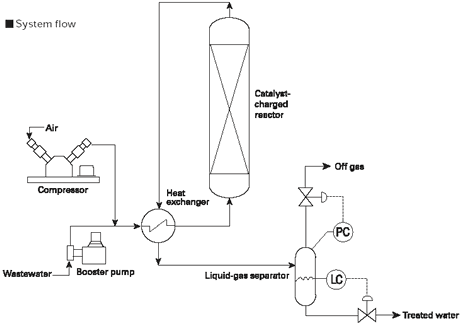Wastewater Treatment Catalysts for Catalytic Wet Air Oxidation (CWAO) Wastewater Treatment Catalysts for Catalytic Wet Air Oxidation (CWAO)
- Applications
- Functions
Basic Information
Nippon Shokubai’s catalytic wet air oxidation (CWAO) is a wastewater treatment method that can be used in place of incineration treatment.We have successfully developed maintenance-free systems that are capable of highly-efficient and low-cost treatment.
Using Nippon Shokubai’s proprietary wastewater treatment catalysts for catalytic wet air oxidation (solid catalysts) to trigger a liquid-phase oxidation reaction with air as the oxidant, we can detoxify highly toxic organic matter, organic nitrogen compounds, ammonia, sulfur compounds, organic chloride, and other hazardous substances into carbon dioxide, water, nitrogen, sulfates, hydrochlorides, and other harmless substances.
We are also able to achieve even more advanced treatment by combining this process with biological treatment in the latter stages.
Features and Properties
- Simultaneous decomposition and removal of COD and compounds containing nitrogen and sulfur
- Low running costs
- Space saving, due to the compact plant design
- Stable, continuous and automatic operation
- Thermal, self-sustained operation is possible without the need for auxiliary fuel, even in CODCr 20,000 mg/L wastewater treatment
- Able to recover the heat from the wastewater oxidation reaction as steam energy
- Deodorization and decolorization are also possible
- Clean exhaust gases without SOx, NOx, and dioxins
- Does not generate secondary pollutants, such as sludge and incinerated ashes
- Able to reuse the treated water as water for cisterns, fire, irrigation, etc. (in high-efficiency treatment)
Examples of Applications
Usable Wastewater
- Hydrocarbon organic matter wastewater (COD components) (also compatible with sparingly degradable biological components (*))
・Wastewater containing formalin*, acetaldehyde*, glyoxal,
・phenol*, dioxane*, MMA,
・formic acid, acetic acid, acetone, tetrahydrofuran (THF), methyl ethyl ketone (MEK), methanol,
・terephthalic acid, ethylene glycol (EG), pentaerythritol, etc. - Sulfur-based wastewater containing sulfide (sodium sulfide, etc.), thiosulfuric acid, DMSO, etc.
… ethylene plant wastewater, spinning plant wastewater, etc. - Nitrogen-based wastewater containing ammonia, isocyanate, acrylonitrile, etc.
- Wastewater containing organic chlorine compounds such as dioxins, etc.
Catalysts
As the wastewater treatment catalysts for catalytic wet air oxidation, Nippon Shokubai’s proprietary solid catalyst developed are charged while in the reactor.
System Overview
This system is composed of the processes of wastewater supply, compressed air supply, heat exchange, catalytic reaction and liquid-gas separation.
